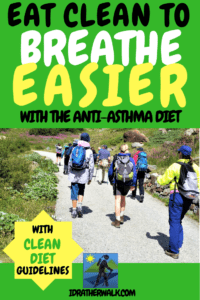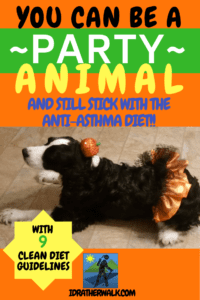Most recently updated July 7th, 2023
The best food for asthma – or any kind of diet – is healthy food that you want to eat and keep eating for a lifetime!
Even when you know what foods to avoid, it’s hard to always stick with it, especially at family events and Holiday gatherings.
I’ve been looking for the best food for asthma and perfecting my own anti asthma diet for a long time – and my own strategies for being social and still sticking to foods that are good for me.
My earliest memory is being inside an oxygen tent when I was a toddler. (I’m in my 50’s now.)
That’s a lot of years’ living with the disease and learning what kind of diet and exercise helps.

Through research and trial and error, I’ve created a diet that helps me breathe easier.
Over time, thanks in part to my diet, I’ve gone from being a medicated Bubble Girl who couldn’t take a deep breath to a 50- something year old woman who does alpine hiking and leads weekly 6-12 mile hikes.
If you’re looking for additional (non-medical) ways to minimize or even eliminate asthma symptoms, this diet could help you, too.
The photos in this post highlight some amazing places I’ve been able to hike in spite of severe chronic asthma. Diet and exercise does make a difference 🙂
Even if you’re not asthmatic, eating a cleaner diet with fewer allergens could improve your lung function.
WARNING: This is a long article, with lots of information. I tell you what the research says, and what I’ve done that works for me. Hopefully, it’s enough for you to decide if a change in diet will help you reach your goals.
A quick review to set the stage….
What is Asthma?
There are many different types of asthma. It can affect the breathing of children or adults, and symptoms range from fairly mild to life-threatening.
Though more complex than an allergic reaction, asthma – like an allergy – is also an immune system response to what the body perceives as an “invader”.
There is no cure, but some people do grow out of it, and medical drugs are available that treat the symptoms. In the U.S., asthma affects more than 25 million people.
WHAT ARE THE symptoms of asthma?
There are three main symptoms:
-
-
- Constriction of bronchial tubes (airways)
- Inflammation of lung tissue
- Thick mucus in the lungs
-
Many people with asthma do not feel sick, and can be very active until they run into something that triggers an asthmatic reaction.

What are Asthma triggers?
Triggers vary with each person, but here are some usual suspects:
-
-
- Exercise or stress
- Smoke – cigarette and fire smoke
- Air Pollution – smog, car exhaust, other air pollution
- Cold dry air
- Sulfites in food
- Alcoholic beverages
- Pollen, Mold and Dust
- Insect bites and stings
- Common cold or sinus infection
-
For the purpose of this article, we’re identifying foods that may reduce symptoms, make symptoms worse, or act as a trigger themselves – like a food allergy.
Food allergies occur when your immune system overreacts – just like with asthma. Except the reaction with a food allergy is to specific proteins in foods. In some cases, this can result in, or trigger asthma symptoms.
NOTE: I am not a medical practitioner, and speak only from my own personal experience. As always, consult your doctor before making substantial changes in your medications or eating habits.

Current Asthma Diet Research
The current official research says there’s no evidence that a specific diet has any effect on the frequency or severity of asthma attacks. There’s also no single diet or food recommended for asthma sufferers.
Some of my posts contain affiliate links. If you make a purchase through an affiliate link, I will receive a small payment at no additional cost to you. I do not get paid for recommendations, all opinions on this site are my own. See full Disclosure page here.
According to some research, a recent shift from eating fresh foods to processed foods may be linked to an increase in diagnosed asthma cases.

A recent study, published in the European Lung Foundation’s European Respiratory Journal, showed that a healthy diet can lead to fewer asthma symptoms, while an unhealthy diet can be detrimental.
(Data gathered from 34,776 French adults who answered a questionnaire in 2017.)
No one has found any foods that reduce the bronchial inflammation of asthma, but drinks that contain caffeine – especially warm coffee – provide some bronchodilation (relaxing constricted airways) for an hour or two.
One recent study of asthma and diet showed that teens with unhealthy diets were the most likely to have poor lung function. In contrast, a 2007 study showed that children who grew up eating a Mediterranean diet — high in nuts, fruits and fish — were less likely to have asthma.
There’s also evidence that diets higher in vitamins C, D, and E, beta-carotene, flavonoids, magnesium, selenium, and omega-3 fatty acids decrease rates of asthma. Many of the above are also antioxidants, which protect cells from damage.
Research Summary
These studies seem to indicate that people with asthma may benefit from eating a diet high in fresh fruits, vegetables, and fish and lower in processed foods, meat, sugar and salt.

The research shows that a healthy diet offers anti-inflammatory benefits that may decrease asthma symptoms, while the unhealthy diet promotes inflammation.
Note that eating a healthier diet overall may improve your asthma symptoms, but it also depends on how healthy you are to start with and the severity of your symptoms.
Most people who start following a healthier diet notice improved energy levels and healthier body weight, whether or not they are asthmatic.
How Do You Find a Diet That Works For You?
Susan Schenck, author of “The Live Food Factor: The Comprehensive Guide to the Ultimate Diet for Body, Mind, Spirit & Planet,” says she learned through trial and error that alleviating asthma has more to do with what you don’t eat than what you do eat.
In my personal asthma diet research (using myself as a guinea pig), I also added or removed various foods and supplements from my diet over time.
This may be your best bet as well.
Wheat and Grains
A 2011 study published in the Journal of Allergy and Clinical Immunology established a link between celiac disease and a greater risk of asthma. It follows that a gluten-free diet might also help those with asthma.
With that in mind, I severely limited my wheat intake. My main airborne trigger is grain dust – released into the air when wheat is harvested or grain is transferred to silos.

My reasoning was that if my lungs hate wheat, perhaps my digestive system does too. Eliminating most wheat and grains (except brown and wild rice) from my diet helped me, but there is some evidence that eating more grains has helped some people.
Do Grains Guard Against Asthma?
According to the USDA, Americans eat about 50% more meat and poultry than they did in the 1930s. Researchers believe that the shift to a more meat-centered diet may be increasing asthma rates.
“In our study, children who got the most calories from cereal and rice and the most protein from cereals, nuts, starch, and vegetables were the ones most protected against wheezing,” explains Philippa Ellwood, research manager for the International Study of Asthma and Allergies in Childhood (ISAAC).
The question for me is whether it was removing the meat from the diet or adding the grains to the diet that provided the positive result.
In addition to eliminating wheat, I stopped eating beef in the 1980’s and stopped eating pork almost 10 years ago. Now I get most of my protein from fish, chicken, eggs, dairy, and nuts.
This diet change has provided a good result for me, but you’ll need to see what works best for your health and your eating habits.
Fruits & Vegetables
Researchers think that fruits and veggies clean up your immune system. The vitamins in produce, especially A, C, and E, act as antioxidants, which help to reduce airway stress and tissue damage.

“As a result, antioxidant-rich produce may help prevent or manage asthma,” explains Lawrence S. Greene, Ph.D., director of the Biology of Human Populations Program at the University of Massachusetts in Boston.
A handful of studies on adults, including a recent British one that looked at apple consumption, showed that apples may help reduce asthma symptoms. Apples (and foods high in Vitamin C in general) have been shown to have anti-histamine properties.
According to a research review article in Nutrition Journal, apples consumption can lower the risk of asthma and increase lung function.
So “an apple a day” is not just an old nursery rhyme. My favorite kind is Braeburn.
A survey published in the European Respiratory Journal found that due to their antioxidant and potassium content, eating just one banana a day reduced the risk of asthma by 34% in the children studied. Vitamin B6, which is abundant in bananas, helps relax bronchial smooth muscle tissue – important for relieving bronchial spasms.
In one animal trial, the pineapple enzyme, bromelain, also appeared to reduce asthmatic inflammation.
Milk and Dairy
Researchers from ISAAC, an Auckland, New Zealand-based group, have been studying the diets of more than 700,000 children from 53 countries, including the U.S, for nearly a decade.

One of their conclusions was that kids who got more calcium from milk and other food were less likely to have asthma symptoms.
Other research from the University of Nottingham in England suggests that milk’s high magnesium content may also account for part of milk’s anti-asthma benefits.
With levels of 300 mg of calcium and 34 mg of magnesium per cup, milk is a great source of these nutrients. (So if your First Grader drinks two cups of milk every day, she’ll get 75% of the calcium and 50% of the magnesium she needs. )
Some other magnesium-rich foods are: spinach, pumpkin seeds, Swiss chard, dark chocolate and salmon. Yogurt or cheese are also good sources.
Inhaling magnesium (through a nebulizer) is also sometimes used to treat asthma attacks.
I eliminated most dairy from my diet, including (alas!) ice cream. I decided to do this because of the mucus-thickening properties in dairy – which was not good for my lungs. I also have a slight lactose intolerance.
Some people with dairy allergies or who are on low-fat diets look for dairy substitutes rather than give it up altogether.
I’m almost dairy-free. Greek yogurt, frozen yogurt, and light-colored cheeses are the exception.
I eat plain unsweetened Greek yogurt for the protein and cultures, and a very small amount of light-colored cheeses (rather than orange cheeses) because they are lower in animal fat.
I eat frozen yogurt because it’s delicious 🙂

Fish, Oils, and Nuts
Two kinds of polyunsaturated fats, omega-6 and omega-3, are required for the best growth and development. According to the USDA, the best ratio of omega-6s to omega-3s to help your immune system fight off disease, is 2.5 to 1.
While omega-3s seem to prevent asthma, research suggests that high levels of omega-6s increase its likelihood.
Too much omega-6 causes the immune system to overproduce chemicals called cytokines that inflame airways and make lungs very sensitive to dust, dander, and pollution.

“Omega-3-rich fish oil dampens cytokine production and calms airways,” explains Robert F. Grimble, Ph.D., professor of nutrition at the University of Southampton in England.
Sadly, research shows that the typical American diet is more than four times the optimum level of omega-6.
How To Add Omega-3s To Your Diet
Eat more fish!! Salmon is my favorite, but tuna, herring, sardines – really any kind of fish – will pump up the omega-3’s in your diet. Canned or fresh are both good sources.
Oiling Up: Canola has an ideal ratio of omega-6s to omega-3s, while olive oil offers mostly monounsaturated fat. Canola oil works best for frying or baking, so it’s a good swap for vegetable oil.
NOTE: I generally avoid eating fried food out because I don’t know what it’s been fried in. I avoid frying food in my own kitchen because of the oil it puts in the air – which is an irritant for me.
Walnuts Win! I recently started putting raw walnuts on my yogurt – because they were on sale. As soon as I ate a handful, my mouth went “Oooh, baby!” As it turns out, walnuts are the only nut rich in omega-3s. So anyway, I eat a handful of walnuts every day now. Your body always knows….
What About Trans Fats?
When you see “partially hydrogenated oil” in the ingredients of processed foods, it’s code for “trans fat”. Trans fats start out as an omega-6 oil, that is then chemically altered when hydrogen is forced into it under pressure. Margarine is chock full of trans fats.

An Australian study found that children who ate a lot of omega-6 fatty acids from margarine and vegetable oil were twice as likely to develop asthma as children whose fat usually came from canola oil, olive oil, or even butter.
This is not surprising, since studies show that digesting and metabolizing trans fats can create leukotrienes, which cause lung inflammation.
Years ago, we were told that margarine was better for us than butter – so for a while I switched to margarine only. It seems that advice was incorrect.
Now I only use olive oil and butter in my cooking.
HOW TO REDUCE TRANS FATS IN YOUR DIET
Just say “Eeew!” to margarine. Most brands are at least 65% vegetable oil. We already know that’s not good for us, especially in a trans fat. You know what’s good? Butter. Or I guess you could try fruit butters and low-fat cream cheese.
Cut Down on Fast Food. Go less often and try healthier kids’ meal options – anything not fried or grilled. When you’re at Wendy’s, McDonald’s, or Burger King, hamburgers are a better choice than nuggets.
Go for Healthy Snacks. Microwave popcorn and potato chips can be loaded with trans fat or omega-6 oils. Try chips made with canola oil or No Oil Added microwave popcorn.
Foods to Eat and Foods to Avoid

Now that you have all this new dietary information, what should you eat?
Beyond that, the world is your oyster… if you aren’t allergic to them 🙂
The Worst Food For Asthma:
- Sulfites, which are found in wine and dried fruits
- Processed Foods and drinks, with ingredients like chemical preservatives
- Trans Fats, found mostly in Margarine and Fast Food
- Food Additives such as colorings, dyes, and artificial sweeteners may trigger asthma symptoms.
- Known Food Allergens, like wheat, dairy or tree nuts
Through practical application, we’ve found that reducing consumption of meats, sugar and salt will likely improve your lung function. Research studies seem to support this conclusion.
More About Food Additives and Preservatives
Some additives and preservatives are strong asthma triggers in some people. The best way to avoid artificial substances in food is to eat unprocessed, organic foods.

Substances that trigger or may worsen asthma symptoms include benzoates, tartrazine, and monosodium glutamate (MSG):
- Benzoates are antimicrobial preservatives that used in various products, particularly soft drinks.
- Tartrazine is an artificial food coloring used in many processed foods, cheeses and pickled products.
- Monosodium glutamate or MSG is a flavor enhancer most commonly used in Chinese restaurants and in many processed foods.
More About Cutting Back on Salt
Studies suggest that high intakes of salt can make airways more reactive to allergens, and worsen asthma symptoms. Regions with high salt consumption also tend to have higher rates of asthma.
Excessive intake of salt can also strip your body of potassium.
Potassium has been shown to improve lung function and reduce incidence of asthma in children.
Try using spices and herbs instead of salt to flavor your food.
Avoid OR LIMIT ALCOHOLIC BEVERAGES
Consuming alcohol can counteract any broncho-dilators or anti-inflammatories you are taking for your asthma, because alcohol is a depressant.
Also, drinks like beer and wine contain other potential allergens/triggers like grain and sulfites.
A celebratory glass or two are okay occasionally, but drinks should be avoided (especially if you’re already having an issue), as they may aggravate your asthma.
Avoid Known Food Allergens
Other foods like grains, dairy and certain nuts should be avoided if you have a known sensitivity to them, as they may aggravate your asthma.

The Best Food for Asthma:
We’ve found from current research studies, and from my own personal research, that people with asthma may benefit from eating a diet high in fresh fruits, vegetables, and fish.
Here are some additional foods and nutrients that may help support lung function:
Vitamins and Minerals
Vitamin D – Getting enough vitamin D may help reduce the number of asthma attacks in children ages 6 to 15, according to the Vitamin D Council. Spending even a few minutes outdoors in the sun can increase your vitamin D. Sources of vitamin D include: sunshine, salmon, milk and fortified milk, fortified orange juice, eggs.
Vitamin A – A 2018 study found that children with asthma typically had lower levels of vitamin A in their blood than children without asthma. Sources of vitamin A include: carrots, cantaloupe, sweet potatoes, leafy greens, such as romaine lettuce, kale, spinach and broccoli.
Vitamin B6 – Foods rich in vitamin B6 (pyridoxine) should be part of any anti-asthma diet. Studies have found pyridoxine to dramatically reduce the intensity and frequency of asthma attacks. Pyridoxine plays a critical role in the production of molecules that help relax bronchial smooth muscle tissue. Sources of Vitamin B6 include – a wide range of foods, bananas being a very rich source of this vitamin.

Vitamins C and E – With it’s strong antioxidant properties, vitamin C (ascorbic acid) is highly effective at neutralizing free radicals that can cause contraction of airway smooth muscles.
Studies have also shown high levels of vitamin C to act as an antihistamine in the body. (Histamine is a chemical produced by the body, that can increase inflammation in asthmatics and cause constriction of smooth muscles.)
Vitamin E is another antioxidant that can help alleviate asthma symptoms such as shortness of breath, coughing, and wheezing. Vitamin C and vitamin E protect each other and are more effective when consumed together.
Calcium, Magnesium and Potassium – Studies have shown that calcium and magnesium may decrease the risk of asthma and increase lung function in people who have asthma. Magnesium is also needed to maintain adequate levels of potassium, another mineral that has been associated with improved lung function and a reduced incidence of asthma. Calcium and Magnesium may be found in dairy products and eggs. Potassium is found in a variety of foods, including root vegetables and green beans.
Antioxidants
Eat plenty of fruits and vegetables. They’re a good source of antioxidants such as beta carotene and bioflavonoids, which may help reduce lung swelling and irritation (inflammation) caused by cell-damaging chemicals known as free radicals.

Bioflavonoids – Quercetin, a bioflavonoid with strong antioxidant, anti-histamine, and anti-inflammatory properties, has been shown to relieve asthma symptoms and allergic symptoms. Sources of quercetin include – apples, yellow and red onions, broccoli, red grapes, cherries, citrus fruits, tea, raspberries, and cranberries.
Rosmarinic Herbs – The antioxidant activity of rosmarinic acid is believed to be superior to that of vitamin E. In addition, rosmarinic acid encourages cells to create prostacyclins, which help keep the air passages of the lungs open which promotes easy breathing. Sources of Rosmarinic acid include – herbs such as rosemary, sage, marjoram, peppermint, oregano, lemon balm, and thyme.
Carotenoids – The carotenoid beta-carotene is a fat-soluble antioxidant that combats free radicals which cause contraction of airway smooth muscles. Sources of beta-carotene include – yellow/orange and green vegetables and fruit such as spinach, carrots, sweet potatoes, winter squash, mango, melon and apricots.
Lycopene – another carotenoid with high antioxidant activity, has been shown to be particularly effective at controlling exercise-induced asthma. Sources of lycopene include – tomatoes, apricots, pink grapefruit, watermelon, and pink guavas.
Read here to learn more about about Vitamins and supplements that can help asthma.
Hydrate

Getting enough water is very important for asthmatics to help them keep their lungs clear.
Plain water is best.
Hydration helps thin any gunk in your lungs so it can be coughed out before it hardens in the bronchioles and then lives there, reducing your lung capacity until you can get it out.
Eating Clean to Prevent Asthma Attacks
The anti-asthma diet that I ended up creating /adopting for myself is very much like the “clean food” diets that are out now.
The fundamentals of eating clean encourage you to consume more whole foods such as fruits, vegetables, lean proteins, whole grains and healthy fats — and limit highly processed snack foods, sweets and other packaged foods.
The most important thing to remember is:
Don’t eat things that aren’t real food. Your body won’t like it.
Just in case you can’t tell if it’s fake food or not, here are some quick guidelines that may help you keep it real 🙂
Eating Clean For Asthma: 9 Guidelines
-
-
- Cook your own food.
- Read nutrition labels.
- Eat whole foods.
- Avoid processed foods – including soda and trans fats.
- Limit added salt, sugars, and sauces.
- Limit wheat, dairy and red meat.
- Eat veggies and fruits every day.
- Limit alcoholic beverages.
- Drink lots of water.
-
By following the guidelines above at least 80% of the time, avoiding my known triggers, and getting plenty of cardio exercise, I’ve been able to stop taking most of my asthma meds, and haven’t had a hospital visit in years.
I target following the guidelines only 80% of the time, because you have to be able to have SOME fun and flexibility.
PARTIES AND HOLIDAYS

For instance, we know that family gatherings at the Holidays, and parties any time, have their own special pitfalls.
You might be around cigarette smoke, or smoke from a bonfire, as well as food and drink you probably shouldn’t have too much of.
In those circumstances, it’s okay to splurge a little and have a glass of wine or a beer, and eat some of that cheesecake – but be sure to pre-medicate before you get there, and drink lots of water.
And, as always have your emergency meds handy and be ready to leave early if you need to.

I spent a week unconscious on a ventilator 30 years ago, after complete respiratory failure. Last winter I hiked part of the Pacific Crest Trail.
To me, this – plus all of the life and adventure that has happened in between – is a big win 🙂 I hope my diet can help you, too.
Click here to learn how you can hike with asthma, too!
Leave a comment with your own anti-asthma diet tips, or if you have a question I will reply as soon as I can.
Check out all of our Fitness and Wellness posts for more tips on how to be active with asthma.
Thanks for stopping by – see you next time! LJ
To Get New Idratherwalk Posts
sent directly to your inbox (how convenient!) Click this Button
If you like this post, please share it!




LJ has spent much of her free time as a single Mom – and now as an empty-nester – hiking in the US and around the world. She shares lessons learned from adventures both local and in exotic locations, and tips on how to be active with asthma, plus travel, gear, and hike planning advice for parents hiking with kids and beginners of all ages. Read more on the About page.

